Russian space probe to crash to Earth within hours

(AP) -- A failed Russian probe designed to travel to a moon of Mars but stuck in Earth orbit will come crashing down within hours, likely in a shower of fragments that survive the fiery re-entry.
The unmanned Phobos Ground is one of the heaviest and most toxic space derelicts ever to crash to Earth, but space officials and experts say the risks are minimal as its orbit is mostly over water and most of the probe's structure will burn up in the atmosphere anyway.
Russia's space agency Roscosmos said the Phobos-Ground will crash between 1641 and 2105 GMT (11:41 a.m. and 4:05 p.m. EST). It could come down anywhere along the route of its next few orbits, which would include Europe, southeast Asia, Australia and South America. The U.S., Canada and much of Russia are outside the risk zone.
"The resulting risk isn't significant," said Prof. Heiner Klinkrad, Head of The European Space Agency's Space Debris Office that is monitoring the probe's descent.
He wouldn't say where exactly the probe may enter the atmosphere, but said that "most of Europe is excluded from an impact risk."
Roscosmos predicts that only between 20 and 30 fragments of the Phobos probe with a total weight of up to 200 kilograms (440 pounds) will survive the re-entry and plummet to Earth.
Klinkrad agreed with that assessment, adding that about 100 metric tons of space junk fall on Earth every year. "This is 200 kilograms out of these 100 tons," he said.
Thousands of pieces of derelict space vehicles orbit Earth, occasionally posing danger to astronauts and satellites in orbit, but as far as is known, no one has ever been hurt by falling space debris.
The Phobos-Ground weighs 13.5 metric tons (14.9 tons), and that includes a load of 11 metric tons (12 tons) of highly toxic rocket fuel intended for the long journey to the Martian moon of Phobos. It has been left unused as the probe got stuck in orbit around Earth shortly after its Nov. 9 launch.
Roscosmos says all of the fuel will burn up on re-entry, a forecast Klinkrad said was supported by calculations done by NASA and the ESA. He said the craft's tanks are made of aluminum alloy that has a very low melting temperature, and they will burst at an altitude of more than 100 kilometers.
"These tanks are expected to release the fuel above 100 kilometers, and then the fuel is going to burn in the atmosphere and later the tanks are going to burn themselves as well," Klinkrad said in a telephone interview from his office in Berlin.
The space era has seen far larger spacecraft to crash. NASA's Skylab space station that went down in 1979 weighed 77 metric tons (85 tons) and Russia's Mir space station that deorbited in 2001 weighed about 130 metric tons (143 tons). Their descent fueled fears around the world, but the wreckage of both fell far away from populated areas.
The $170-million Phobos-Ground was Russia's most expensive and the most ambitious space mission since Soviet times. The spacecraft was intended to land on the crater-dented, potato-shaped Martian moon, collect soil samples and fly them back to Earth, giving scientists precious materials that could shed more light on the genesis of the solar system.
Russia's space chief has acknowledged the Phobos-Ground mission was ill-prepared, but said that Roscosmos had to give it the go-ahead so as not to miss the limited Earth-to-Mars launch window.
Its predecessor, Mars-96, which was built by the same Moscow-based NPO Lavochkin company, also suffered an engine failure and crashed shortly after its launch in 1996. Its crash drew strong international fears because of some 200 grams of plutonium onboard. The craft eventually showered its fragments over the Chile-Bolivia border in the Andes Mountains, and the pieces were never recovered.
The worst ever radiation spill from a derelict space vehicle came in January 1978 when the nuclear-powered Cosmos 954 satellite crashed over northwestern Canada. The Soviets claimed the craft completely burned up on re-entry, but a massive recovery effort by Canadian authorities recovered a dozen fragments, most of which were radioactive.
The Phobos-Ground also contains a tiny quantity of the radioactive metal Cobalt-57 in one of its instruments, but Roscosmos said it poses no threat of radioactive contamination.
©2012 The Associated Press. All rights reserved. This material may not be published, broadcast, rewritten or redistributed.





















